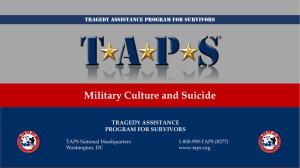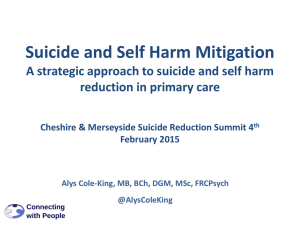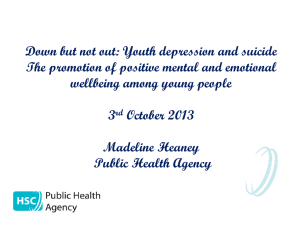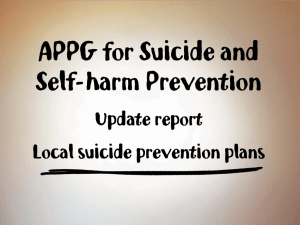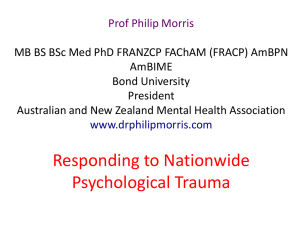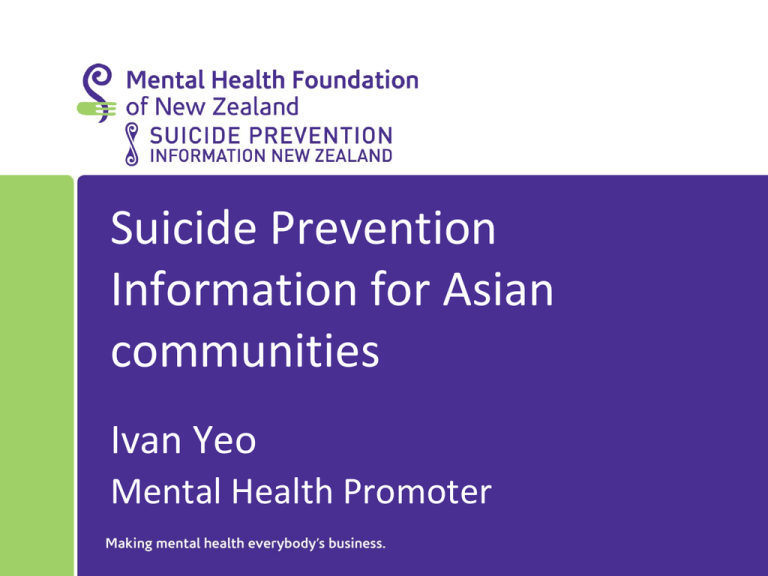
Suicide Prevention
Information for Asian
communities
Ivan Yeo
Mental Health Promoter
“Suicide and suicidal behaviours are a major
health and social issue in New Zealand.
Each year approximately 500 people take
their own lives.
This figure represents a tragic loss of
potential and a tremendous impact on
those families, friends, workplaces and
communities that are affected by the loss of
someone through suicide”.
Ministry of Health (2012)
Suicide in NZ: 2009
• A total of 506 people
died by suicide
• This equates to 11.2
deaths per 100,000
population
(age-standardised).
• The 2009 suicide rate
was 25.5% below the
peak rate in 1998.
Sex
• There is a distinct gender difference in
suicide rates. 77% of suicide deaths in 2009
were males.
• 391 male deaths (17.8 deaths per 100,000 male
population, age-standardised).
• 115 female deaths (5.0 deaths per 100,000
female population, age-standardised).
• The 2009 male suicide rate was 25.4% below the
peak rate in 1995. The female suicide rate has
remained steady over time.
Ministry of Health (2012)
Asian suicide deaths in NZ: 2004-2009
•
•
•
•
•
•
2009: 25 (16 male, 9 female)
2008: 17 (9 male, 8 female)
2007: 14 (8 male, 6 female)
2006: 14 (5 male, 9 female)
2005: 13 (6 male, 7 female)
2004: 10 (6 male, 4 female)
• Difficult to identify trends: NZ’s Asian population
has changed significantly over this time.
• Age-standardised rates are not calculated:
because the numbers of deaths are small, “rates
tend to be highly variable and may be misleading”
There are at least 2500 admissions to
hospital for serious intentional selfharm injuries every year.
For data comparability purposes, this figure excludes
patients who were discharged from an emergency
department with a length of stay of less than two
days.
Ministry of Health. (2012).
Intentional Self-Harm Hospitalisation
(Asian Population)
• 2009: 87 (3.4 % of total).
Females accounted for 58.6 % of all Asian
intentional self-harm hospitalisations.
• 2008: 83 (3.4 % of total), 60.2 % female.
• 2007: 109 (4.1 % of total), 69.7% female.
• 2006: 85 (3 % of total), 71% female.
Why
DoDo
People
Take
Their
Own
Life?
Why
People
Take
Their
Own
Life?
There are no simple or definitive explanations
as to why people die by suicide
The reasons that people choose to take their
own life are very complex, and often the
reasons are not clear to others.
Commonwealth of Australia (2005)
Associate Minister of Health (2006)
Chinese often regard mental health problems,
including depression and suicidal behaviours, to
be caused by social factors, such as a failure to
fulfil family and societal expectations.
In Chinese culture, there is a strong stigma
attached to suicide, which is often seen as
shameful to both the individual and the collective
esteem of the family.
Completing suicide is not really seen as an
individual act, but greatly impacts on families and
significant others.
Suicide Prevention Information New Zealand (2010)
Anecdotal evidence has suggested that the
prevalence of self-harm and suicide attempts
are increasing.
Research in these areas has not yet been
focused solely about Asians in New Zealand.
Health and Wellbeing of Asian Students:
Youth’07 survey
• 15% Asian secondary school students reported
having suicidal thoughts in the past year, and
• 8% had made a plan to attempt suicide
• 4% had made a suicide attempt in the past year.
• Overall, 20% of Asian male students and 31% of
Asian female students had ‘poor’ mental and
emotional health (WHO-5 Wellbeing Index)
Parackal et al (2011)
For Chinese, Indian and other Asian students,
depressive symptoms and suicidal thoughts &
behaviours were more prevalent for females.
• For Chinese students, the proportion who had
thoughts of suicide decreased from 23% in 2001 to
15% in 2007, and the proportion who attempted
suicide decreased from 10% in 2001 to 4% in 2007.
• For Indian students, there were no significant changes
from 2001 to 2007 in suicide-related behaviours.
• Among Chinese and Indian students, 18% of females
and 7-8% of males showed significant depressive
symptoms. (no change 2001-2007)
• Chinese, Indian and other Asian students are
more likely than NZ European students to report
obstacles to accessing healthcare.
• In 2007, 14% of Chinese students, 17% of Indian
students and 16% of Asian students had been
unable to access healthcare when they needed it.
• Major obstacles included
- lack of knowledge about the healthcare system;
- cost and transport;
- concerns about confidentiality; and
- “not wanting to make a fuss”.
Youth’07 recommended:
• Recognise the diversity and specific needs of the
many Asian communities in Aotearoa New Zealand.
• Develop culturally appropriate programmes to destigmatise mental health issues.
• Provide resources, programmes and strategies that
enable the healthy development of Asian young
people.
International and New Zealand
literature suggest that resiliency
and protective factors can be more
effective and insightful than solely
focusing on risk and vulnerability.
Ihimaera, L., & MacDonald, P. (2009) pg32
Defining Risk & Protective Factors
• Risk factors: increase the likelihood of suicidal
behaviour or make a person more vulnerable; and
• Protective factors: reduce the likelihood of
suicidal behaviour and work to improve a
person’s ability to cope with difficult
circumstances.
Commonwealth of Australia. (2005)
Risk and proactive factors can occur at:
• individual or personal level (mental and physical health,
self-esteem, and ability to deal with difficult
circumstances, manage emotions, or cope with stress);
• social level (relationships and involvement with others
such as family, friends, workmates, the wider
community and the persons sense of belonging); and
• contextual level or the broader life environment (social,
political, environmental, cultural and economic factors
that contribute to available options and quality of life)
Commonwealth of Australia. (2005)
Protective factors may include:
•
•
•
•
•
•
•
•
•
connectedness to family
personal resilience, coping and problem-solving skills
responsibility for children
family communication patterns
presence of a significant other
good physical and mental health
positive beliefs and values
community and social integration
economic security in older age.
Commonwealth of Australia. (2005)
For Asian communities
•
•
•
•
family cultures
community connection
access to services and resources
destigmatising mental illness
Current gaps
• research to understand suicidality and
protective factors in New Zealand’s Asian
communities.
• culturally competent and accessible
services.
• accessible resources for a range of Asian
groups.
Mental Health Foundation
• focuses on creating a society where all people
can flourish and experience positive mental
wellbeing.
• suicide prevention is a core focus of our work,
which includes working with communities and
professionals to support safe and effective
suicide prevention activities, reduce stigma and
develop positive mental health and wellbeing.
Suicide Prevention Information
New Zealand
• a national information service provided by the
Mental Health Foundation of New Zealand.
• provides high quality information to promote safe
and effective suicide prevention activities.
• contracted by the Ministry of Health to support the
New Zealand Suicide Prevention Strategy 2006-2016.
Goals of NZSPS
1. Promote mental health
and well-being, and
prevent mental health
problems
2. Improve the care of
people who are
experiencing mental
disorders associated
with suicidal behaviours
3. Improve the care of
people who make nonfatal suicide attempts
4. Reduce access to the
means of suicide
Associate Minister of Health. (2006).
Goals of NZSPS
5. Promote the safe
reporting and portrayal
of suicidal behaviour by
the media
6. Support families/
whānau, friends and
others affected by a
suicide or suicide
attempt
7. Expand the evidence
about rates, causes and
effective interventions.
Associate Minister of Health. (2006).
“Asian groups are
culturally diverse and
have varying degrees of
acculturation to New
Zealand society…
Consequently, suicide
prevention policies,
programmes and services
need to account for this
diversity”
Associate Minister of Health. (2006).
References
•
•
•
•
•
•
Associate Minister of Health. (2006). The New Zealand Suicide Prevention Strategy
2006 – 2016. Wellington: Ministry of Health.
Commonwealth of Australia. (2005). A Framework for Effective Community-Based
Suicide Prevention (Draft for Consultation). Australian Government’s Community Life
Project: Adelaide.
Ihimaera, L., & MacDonald, P. (2009). Te Whakauruora. Restoration of Health: Maori
Suicide Prevention Resource. Wellington: Ministry of Health
Ministry of Health (2012) Suicide Facts 2009: Deaths and intentional self-harm
hospitalisations. Wellington: Ministry of Health
Parackal, S., Ameratunga, S., Tin Tin, S., Wong, S., & Denny, S. (2011). Youth’07: The
health and wellbeing of secondary school students in New Zealand: Results for
Chinese, Indian and other Asian students. Auckland: The University of Auckland.
Suicide Prevention Information New Zealand (2010) adaptation of Department of
Communities, The State of Queensland (2010) Responding to people at risk of suicide:
How can you and your organisation help? Auckland: Mental Health Foundation of
New Zealand.






